High Impact Tutoring Built By Math Experts
Personalized standards-aligned one-on-one math tutoring for schools and districts
In order to access this I need to be confident with:
Area of a rectangle Area of a quadrilateral Area of a triangleInterior angles in polygons
Isosceles triangle Pythagoras theoremTrigonometry
Area of a pentagon
Here you will learn about the area of a pentagon, including how to find the area of a pentagon made from a triangle and a rectangle and how to find the area of a regular pentagon.
Students will first learn about the area of a pentagon as a part of geometry in high school.
What is the area of a pentagon?
The area of a pentagon is the amount of space inside a 2D, five-sided polygon. A regular pentagon is a type of pentagon that has equal sides and all angles have an equal measure.
The area of a regular polygon can be found by splitting the shape into congruent isosceles triangles. You can find the area of one of the triangles and then multiply by the number of sides to find the total area of the regular polygon.
To find the area of a regular pentagon, you can use the following formulas,
The area of a regular pentagon can be calculated by:
\text {Area of a regular pentagon }=5 \times \text { area of one triangle. }The formula for the area of a regular pentagon can also be written as
\text {Area of a regular pentagon }=5 \times \cfrac{1}{2} \, b h.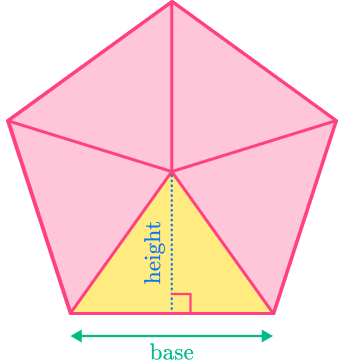
Where b is the base length (or the side of the pentagon) and h is the perpendicular height of the triangle. Sometimes these values will need to be calculated.
For example,
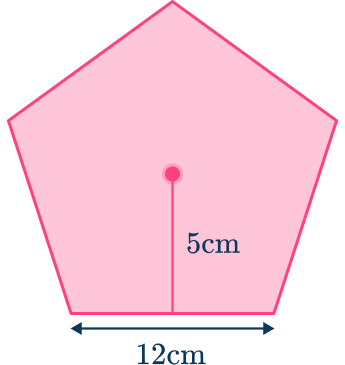
The area of this regular pentagon is
\begin{aligned}& =5 \times \cfrac{1}{2} \times 12 \times 5 \\\\ & =150 \mathrm{~cm}^2 \end{aligned}![[FREE] Area Worksheet (Grade 4 to 6)](https://thirdspacelearning.com/wp-content/uploads/2023/07/Area-check-for-understanding-quiz-listing-image.png)
[FREE] Area Worksheet (Grade 4 to 6)
![[FREE] Area Worksheet (Grade 4 to 6)](https://thirdspacelearning.com/wp-content/uploads/2023/07/Area-check-for-understanding-quiz-listing-image.png)
Use this quiz to check your grade 4 to 6 students’ understanding of area. 15+ questions with answers covering a range of 4th, 6th and 7th grade area topics to identify areas of strength and support!
DOWNLOAD FREE![[FREE] Area Worksheet (Grade 4 to 6)](https://thirdspacelearning.com/wp-content/uploads/2023/07/Area-check-for-understanding-quiz-listing-image.png)
[FREE] Area Worksheet (Grade 4 to 6)
![[FREE] Area Worksheet (Grade 4 to 6)](https://thirdspacelearning.com/wp-content/uploads/2023/07/Area-check-for-understanding-quiz-listing-image.png)
Use this quiz to check your grade 4 to 6 students’ understanding of area. 15+ questions with answers covering a range of 4th, 6th and 7th grade area topics to identify areas of strength and support!
DOWNLOAD FREEArea of an irregular pentagon
An irregular pentagon may have been formed by combining other shapes such as rectangles and triangles. The area of each of these can be found and added together to find the area of the pentagon.
For example,
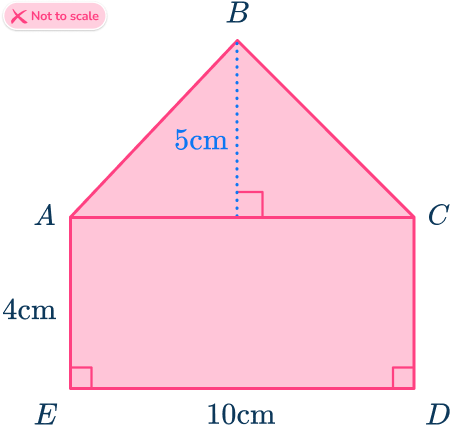
The area of irregular pentagon ABCDE is
\text{Total area }=(\cfrac{1}{2}\times 10\times 5)+(4\times 10)=25+40=65 \ cm^2.Angles in a regular pentagon
You can find the angles of a regular polygon to answer a variety of different area questions.
Splitting the regular pentagon into 5 congruent isosceles triangles, use the angle fact that the sum of internal angles at a point is 360^{\circ} to find the angle at the top of the isosceles triangle.
360\div 5=72^{\circ}The equal base angles can be found by using the angle fact that the sum of angles in a triangle is 180^{\circ}.
(180-72)\div 2=54^{\circ}
Step-by-step guide: Types of angles
The radii of a regular pentagon
A regular pentagon has five radii. The apothem is the radius of the inscribed circle, R_i.
The radius of the inscribed circle is perpendicular to the sides of the regular pentagon and meets the side at the midpoint.
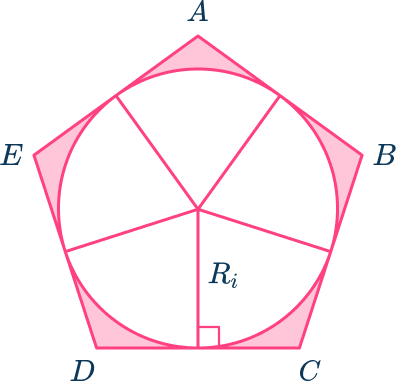
When a regular pentagon is drawn within a circle the circle is known as the circumcircle and the radius is R_c.
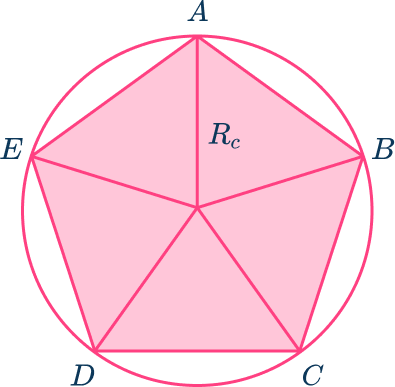
Area formula using the perimeter and apothem of a pentagon
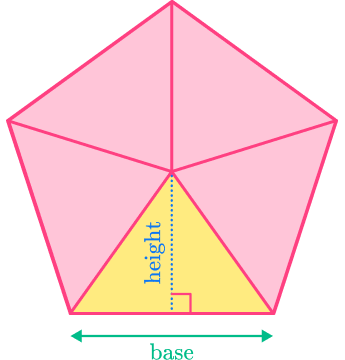
The height (or inscribed radius) in this regular pentagon is also known as the apothem of the pentagon.
We can use the following formula to find the area of a regular pentagon,
\text{Area of a regular pentagon }= \cfrac{1}{2}\times \text{ perimeter }\times \text{ apothem}.The perimeter of the pentagon can be found by multiplying the side length by 5.
What is the area of a pentagon?
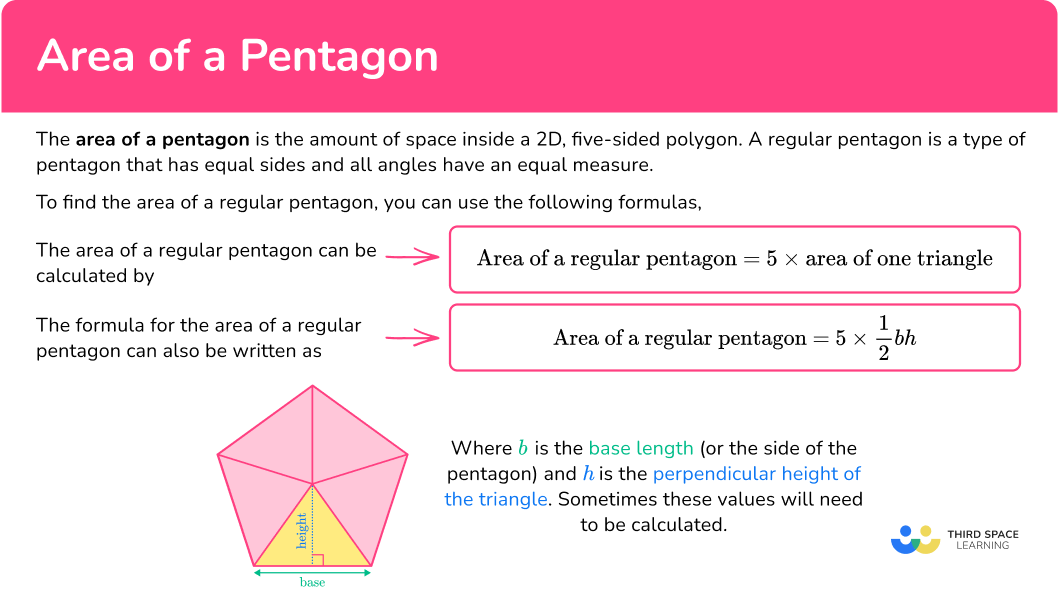
Common Core State Standards
How does this relate to high school math?
- High School: Geometry (HS.G.SRT.D.11)
Understand and apply the Law of Sines and the Law of Cosines to find unknown measurements in right and non-right triangles (e.g., surveying problems, resultant forces).
How to find the area of a pentagon
In order to find the area of a pentagon, you will:
- Consider the pentagon as a compound shape and split it appropriately.
- Calculate the area of the parts.
- Calculate the total area of the pentagon.
- Write the answer, including the correct units.
Area of a pentagon examples
Example 1: area of an irregular pentagon formed with one triangle and a rectangle
ABCDE is a pentagon.
Find the area of the pentagon.
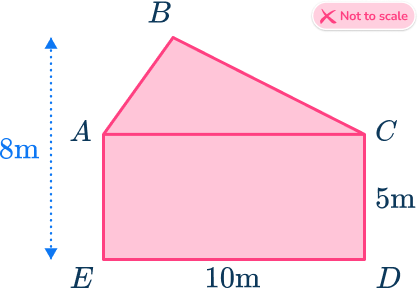
- Consider the pentagon as a compound shape and split it appropriately.
The diagram given in the question is already split into a rectangle and a triangle.
2Calculate the area of the parts.
Find the area of the triangle ABC.
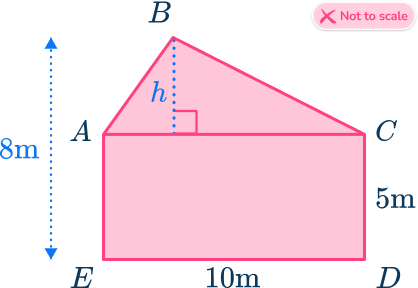
The height of the triangle, h, is h=8-5=3.
Therefore, the area of the triangle is A=\cfrac{1}{2} \, bh=\cfrac{1}{2}\times 10\times 3=15.
The area of the rectangle ACDE is A=bh=10\times 5=50.

3Calculate the total area of the pentagon.
The total area of the pentagon is found by adding the area of the triangle and the area of the rectangle together.
\text{Total Area }=15+50=654Write the answer, including the correct units.
The dimensions of the shape are given in meters, so the units of the area will be in square meters. The area of pentagon ABCDE is 65 \, m^2.
Example 2: area of an irregular pentagon formed with one isosceles triangle and a rectangle
ABCDE is a pentagon.
Calculate the area of the pentagon.
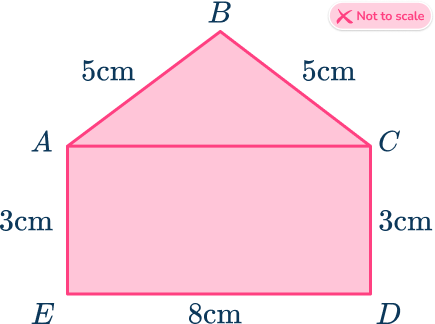
Consider the pentagon as a compound shape and split it appropriately.
The diagram given in the question is already split into a rectangle and a triangle.
Calculate the area of the parts.
Find the area of the triangle ABC.
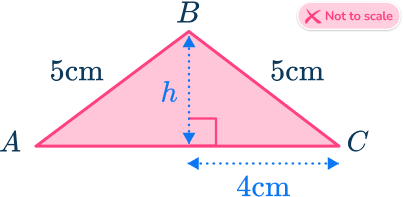
You can find h the height of the triangle by using Pythagoras’ theorem.
h=\sqrt{5^2-4^2}=3
Note: The height can also be found as it is part of the 3, 4, 5 Pythagorean triple.
Therefore, the area of the triangle is A=\cfrac{1}{2} \, bh=\cfrac{1}{2}\times 8\times 3=12.
The area of the rectangle ACDE is A=bh=8\times 3=24.
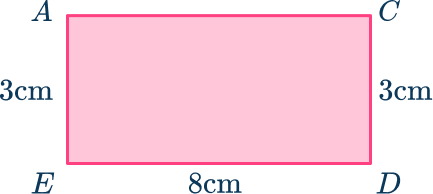
Calculate the total area of the pentagon.
The total area of the pentagon is found by adding the area of the triangle and the area of the rectangle together.
\text{Total Area }=12+24=36
Write the answer, including the correct units.
The dimensions of the shape are given in centimeters, so the units of the area will be in square centimeters. The area of pentagon ABCDE is 36 \, cm^2.
Example 3: calculating the area of a regular pentagon given the area of one of the isosceles triangles
Calculate the area of the regular pentagon ABCDE given that the area of one of the congruent triangles is 20 \, cm^2.
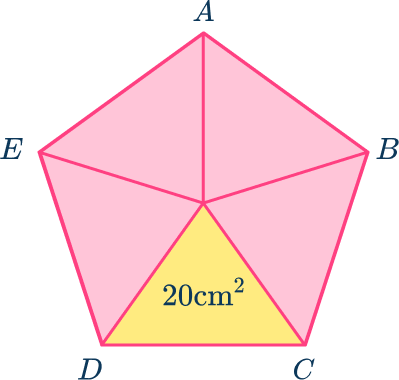
Consider the pentagon as a compound shape and split it appropriately.
The diagram given in the question is already split into five congruent isosceles triangles.
Calculate the area of the parts.
The area of one triangle has been given, 20 \, cm^2.
Calculate the total area of the pentagon.
The total area of the regular pentagon is
\text{Area of a regular pentagon }=5\times \text{ Area of one triangle}
\begin{aligned}&=5\times 20 \\\\ &=100 \end{aligned}
Write the answer, including the correct units.
The area of pentagon ABCDE is 100 \, cm^2.
Example 4: area of a pentagon given the side length
Calculate the area of the regular pentagon ABCDE given that the length of one side of the regular pentagon is 10 \, cm.
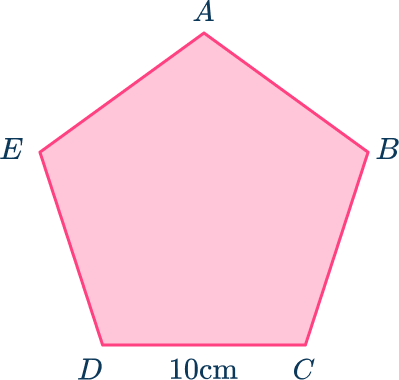
Consider the pentagon as a compound shape and split it appropriately.
Here, the regular pentagon ABCDE has been split into five congruent isosceles triangles.
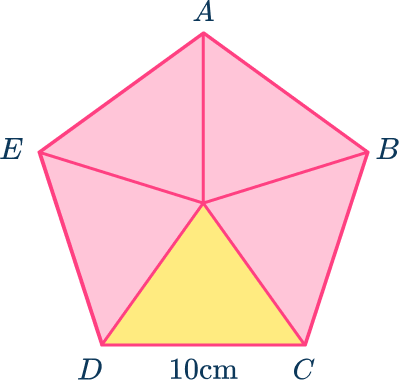
Calculate the area of the parts.
You can find the area of one of the isosceles triangles by using the side length as the base length of the triangle.
You need to work out the height of the triangle. This can be done using trigonometry and the angles in the triangle.

\text{height}=\tan(54)\times 5=6.8819…
The area of one of the isosceles triangles is
Calculate the total area of the pentagon.
The total area of the regular pentagon is
\text{Area of a regular pentagon }=5\times \text{ area of one triangle}
Write the answer, including the correct units.
The dimensions of the shape are given in centimeters, so the units of the area will be in square centimeters. The area of pentagon ABCDE is 172 \, cm^2 (to 3 significant figures).
Example 5: area of a pentagon given the height (apothem)
Calculate the area of the regular pentagon ABCDE given that the length of the apothem of the regular pentagon is 12 \, cm.
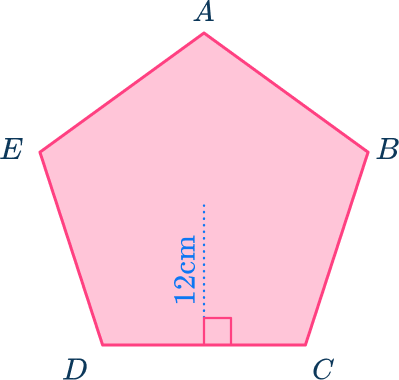
Consider the pentagon as a compound shape and split it appropriately.
Here, the regular pentagon ABCDE has been split into five congruent isosceles triangles.
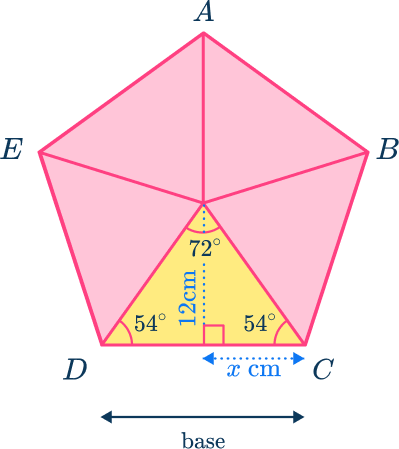
Calculate the area of the parts.
You can find the area of one of the triangles by using the apothem as the perpendicular height of the triangle.
You need to work out the base of the triangle. This can be done using trigonometry and the angles in the isosceles triangle.
x=12\div \tan(54)=8.7185…
The base of one of the isosceles triangles is
\text{base}=2x=2\times 8.7185…=17.4370…
The area of one of the isosceles triangles is
Calculate the total area of the pentagon.
The total area of the regular pentagon is
\text{Area of a regular pentagon }=5\times \text{ area of one triangle}
Write the answer, including the correct units.
The dimensions of the shape are given in centimeters, so the units of the area will be in square centimeters. The area of pentagon ABCDE is 523 \, cm^2 (to 3 significant figures).
Example 6: area of a pentagon given the radius of the circumcircle
Calculate the area of the regular pentagon ABCDE given that the length from the center of the pentagon to the vertices is 15 \, cm.
Consider the pentagon as a compound shape and split it appropriately.
Here is a sketch of the regular pentagon ABCDE showing the five congruent isosceles triangles.
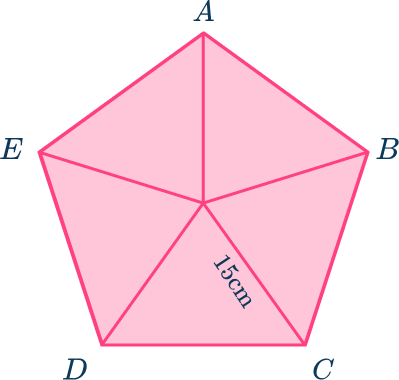
Calculate the area of the parts.
You need to work out the height of the triangle using trigonometry and the angles in the isosceles triangle. The hypotenuse is 15 \, cm.
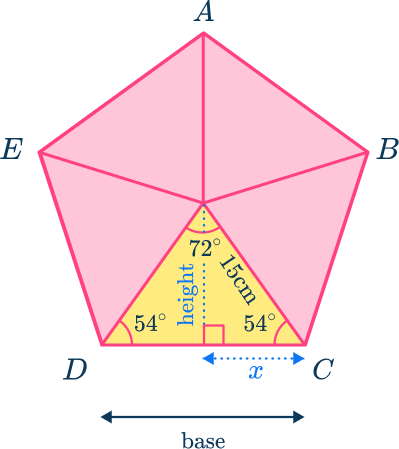
\text{height}=\sin(54)\times 15=12.13525…
You need to work out the base of the triangle using trigonometry and the angles in the isosceles triangle. The hypotenuse is 15 \, cm.
x=\cos(54) \times 15=8.81677…
The base of one of the isosceles triangles is
\text{base}=2x=2\times 8.81677…=17.63355…
The area of one of the isosceles triangles is
Calculate the total area of the pentagon.
The total area of the regular pentagon is
\text{Area of a regular pentagon }=5\times \text{ area of one triangle}
Write the answer, including the correct units.
The dimensions of the shape are given in centimeters, so the units of the area will be in square centimeters. The area of pentagon ABCDE is 535 \, cm^2 (to 3 significant figures).
Example 7: area of a pentagon given the radius of the circumcircle (diagonals)
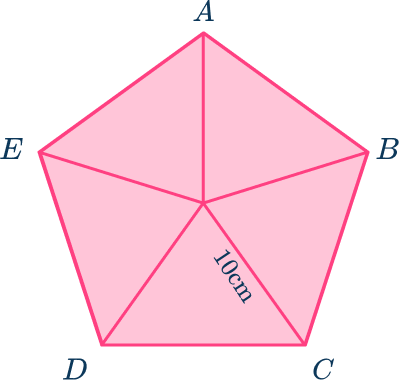
Consider the pentagon as a compound shape and split it appropriately.
The diagram given in the question is already split into five congruent isosceles triangles.
Calculate the area of the parts.
You need to work out the area of one of the triangles using trigonometry and the angles in the isosceles triangle. You can use HIGHER trigonometry.
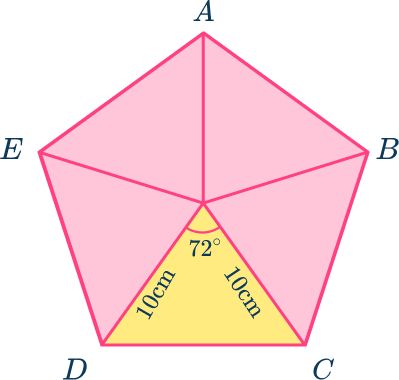
Calculate the total area of the pentagon.
The total area of a regular pentagon is
\text{Area of a regular pentagon }=5\times \text{ area of one triangle}
Write the answer, including the correct units.
The dimensions of the shape are given in centimeters, so the units of the area will be in square centimeters. The area of pentagon ABCDE is 238 \, cm^2 (to 3 significant figures).
Teaching tips for the area of a pentagon
- Start by breaking down the formula for the area of a regular pentagon. This isn’t as commonly memorized as some other formulas, so students will benefit from the additional instruction.
- Instead of giving students worksheets to work on independently, consider allowing students to work through these practice problems in small groups or in pairs. This allows students to discuss and collaborate on answers, which can lead to students learning from one another.
- Use technology, such as an online pentagon calculator or geometry software, which allows learning to be more interactive and engaging for some students.
Easy mistakes to make
- Using the wrong units
Remember that area is measured in square units. Square units include square centimeters (cm^2), square meters (m^2) and square millimeters (mm^2).
- Confusing regular and irregular pentagons
It’s important to identify whether a pentagon is regular or irregular before calculating the area. Remember regular pentagons have all equal sides, while irregular pentagons do not.
Practice area of a pentagon questions
1. Calculate the area of the irregular pentagon ABCDE given that ACDE is a rectangle.
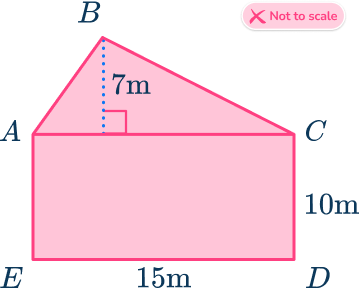




The area of the triangle ABC is A=\cfrac{1}{2} \, bh=\cfrac{1}{2}\times 15\times 7=52.5.
The area of the rectangle ACDE is A=bh=15\times 10=150.
The total area of the pentagon is found by adding the area of the triangle and the area of the rectangle together.
\text{Total Area}=52.5+150=202.5 \ m^2
2. Calculate the area of the irregular pentagon ABCDE given that ABC is an isosceles triangle and ACDE is a rectangle.
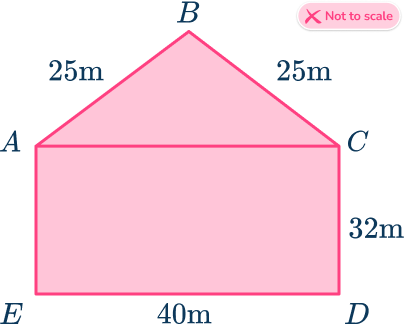




The height of the triangle is h=\sqrt{25^2-20^2}=15.
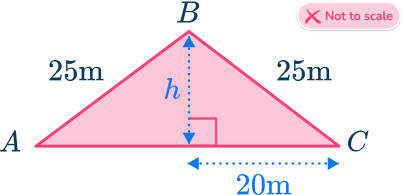
The area of the triangle ABC is A=\cfrac{1}{2} \, bh=\cfrac{1}{2}\times 40\times 15=300.
The area of the rectangle ACDE is A=bh=40\times 32=1280.
The total area of the pentagon is found by adding the area of the triangle and the area of the rectangle together.
\text{Total Area}=300+1280=1580 \ m^2
3. Calculate the area of the regular pentagon ABCDE given that the area of one of the congruent triangles is 15 \, cm^2.
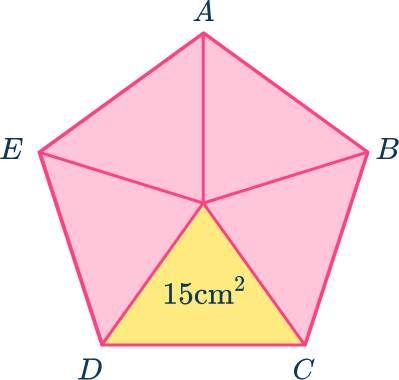




The area of the regular pentagon is
\begin{aligned} & =5 \times \text { area of one triangle } \\\\ & =5 \times 15 \\\\ & =75 \mathrm{~cm}^2 \end{aligned}
4. Calculate the area of the regular pentagon ABCDE given that the side length is 20 \, cm.
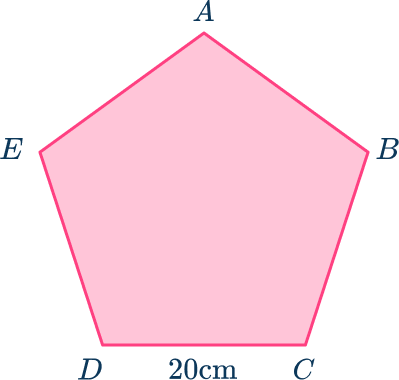




The height of the triangle is
\text{height}=\tan(54)\times 10=13.7638…
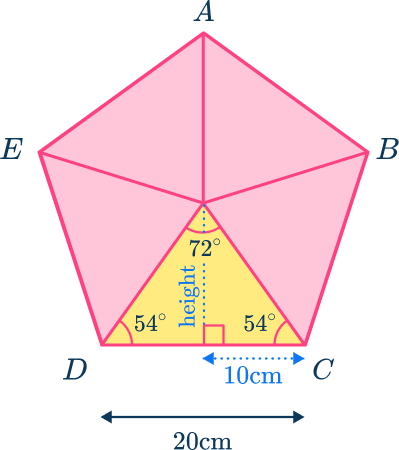
The area of one of the isosceles triangles is
\begin{aligned}A&=\cfrac{1}{2} \, bh \\\\ &=\cfrac{1}{2}\times 20\times 13.7638… \\\\ &=137.638… \end{aligned}
The area of the regular pentagon is
\begin{aligned} & =5 \times \text { area of one triangle } \\\\ & =5 \times 137.638 \\\\ & =688.190 \ldots \end{aligned}
The area of the regular pentagon is 688 \, cm^2 to 3 significant figures.
5. Calculate the area of the regular pentagon ABCDE given that the distance from the center of the pentagon to the midpoint of one of the sides is 40 \, cm.
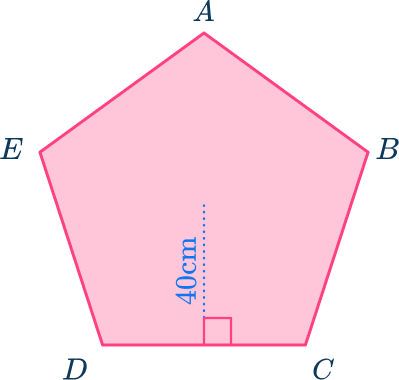




Using trigonometry,
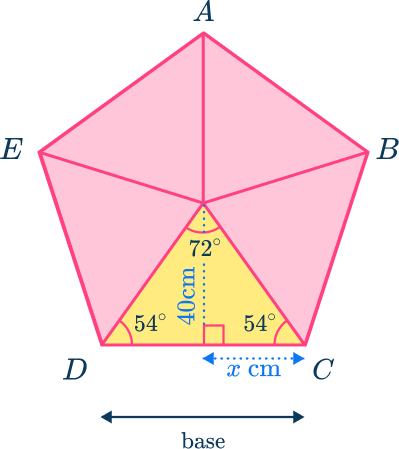
x=40\div \tan(54)=29.0617…
The base of one of the isosceles triangles is
\text{base}=2x=2\times 29.0617…=58.1234…
The area of one of the isosceles triangles is
\begin{aligned}A&=\cfrac{1}{2}bh. \\\\ &=\cfrac{1}{2}\times 58.1234…\times 40 \\\\ &=1162.468… \end{aligned}
The area of the regular pentagon is
\begin{aligned} & =5 \times \text { area of one triangle } \\\\ & =5 \times 1162.468 \ldots \\\\\ & =5812.34 \ldots \end{aligned}
The area of pentagon ABCDE is 5810 \, cm^2 (to 3 significant figures).
6. Calculate the area of the regular pentagon ABCDE given that the distance between the center of the pentagon and one of the vertices is 17 \, cm.
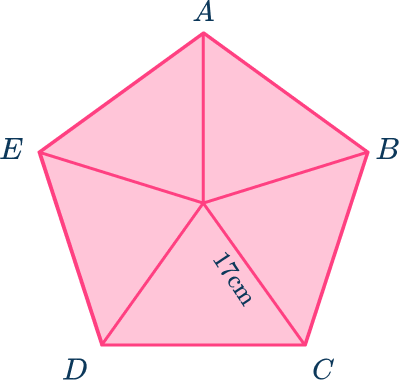




Using trigonometry,
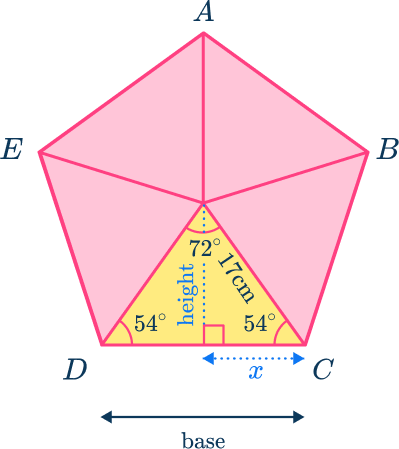
The height of the triangle can be calculated using trigonometry and the angles in the isosceles triangle. The hypotenuse is 17 \, cm.
\text{height}=\sin(54)\times 17=13.7532…
You need to work out the base of the triangle using trigonometry.
x=\cos(54) \times 17=9.9923…
The base of one of the isosceles triangles is
\text{base}=2x=2\times 9.9923…=19.9846…
The area of one of the isosceles triangles is
\begin{aligned}A&=\cfrac{1}{2}bh. \\\\ &=\cfrac{1}{2}\times 19.9846…\times 13.7532… \\\\ &=137.427… \end{aligned}
The area of the regular pentagon is
\begin{aligned} & =5 \times \text { area of one triangle } \\\\ & =5 \times 137.427 . . \\\\ & =687.138 \ldots \end{aligned}
The area of pentagon ABCDE is 687 \, cm^2 (to 3 significant figures).
Area of a pentagon FAQs
A formula that can be used to find the area of a pentagon is
\text{Area of a regular pentagon } = 5 \, \times \text{ area of one triangle,} or
\text{Area of a regular pentagon } = 5 \times \cfrac{1}{2} \, bh.
The apothem is the distance from the center of a polygon to its sides. To find the apothem, find the center of the shape and then draw a line from the center to the midpoint of one side of a pentagon.
The next lessons are
Still stuck?
At Third Space Learning, we specialize in helping teachers and school leaders to provide personalized math support for more of their students through high-quality, online one-on-one math tutoring delivered by subject experts.
Each week, our tutors support thousands of students who are at risk of not meeting their grade-level expectations, and help accelerate their progress and boost their confidence.

Find out how we can help your students achieve success with our math tutoring programs.
[FREE] Common Core Practice Tests (3rd to 8th Grade)
Prepare for math tests in your state with these 3rd Grade to 8th Grade practice assessments for Common Core and state equivalents.
Get your 6 multiple choice practice tests with detailed answers to support test prep, created by US math teachers for US math teachers!